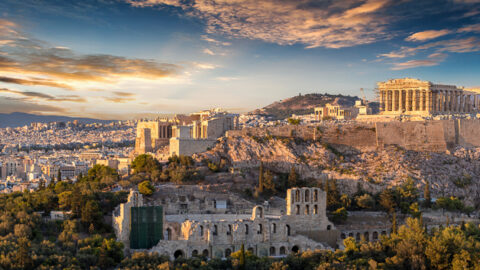(CNN) — It was the movie that added sex appeal to the gritty neorealist film period and made a star out of actress Silvana Mangano.
“Riso Amaro” (“Bitter Rice”), featured women wearing daring shorts with ripped stockings tramping through water, girl-on-girl mud-wrestling, and Mangano’s ample cleavage in everything from tight t-shirts to a negligee.
The film, a neorealist thriller-slash-tragedy, saw a criminal couple infiltrate the rice fields in Italy’s Piedmont region, and ticked off gun fights and a rice heist.
Trust the Italians to make farming sexy, you could say. But despite all the cleavage shots, “Bitter Rice” threw the spotlight on a job that had been, until then, thankless.
Every summer, from May to July, until the 1960s (and even 1970s in some places) thousands of working-class women would make their way to the Po Valley in northern Italy. They were there to work as “mondine” — field weeders, clearing space for the rice plants to grow.
It was backbreaking work.
“They were knee-high in water, exposed to the sun, and there was a high prevalence of disease, including malaria. One senator who made a speech on their conditions [in 1953] likened them to one of Dante’s circles of hell.”
On being taught the technique, Silvana Mangano (who, incidentally, was the grandmother of US TV chef Giada de Laurentiis) is said to have exclaimed: “Like this, for eight hours? I wouldn’t do this work even for a million a day!”
But Derounian says there was far more to the mondine than feeding the nation. Largely left wing, they were some of the only workers to successfully protest against the Fascist government, and carried out important work as part of the anti-Nazi resistance during World War II.
“They did a lot of things like hiding partisans, and passing on messages and materials,” she says.
But they were often passed over during post-war efforts to recognize the partisans. And sometimes, that passing over came from their own families — even when they’d worked in the resistance together (men would do active combat and women would hide fighters, provide food and pass on messages).
“There was one case where the authorities came to give ‘tessere’ [cards of recognition for the war effort] to members of one family. The husband said, no, just one in the family is enough — I’ll have mine. The woman — a ‘mondina’ — never got her tessera,” says Derounian.
Scandal and starpower

Italy’s rice belt follows the River Po across the north of the country, from Piedmont to Veneto.
G. GNEMMI/De Agostini Editorial/Getty Images
So how did a humble grain get to play center stage in Italy’s anti-Fascist resistance? It’s thought that rice was first domesticated in China’s Yangtze River valley around 10,000 years ago. Before that, locals had harvested wild rice for a couple more thousand years.
Either way, production revolved around Italy’s “rice belt” — the dank, marshy land around the Po river, running west to east across Piedmont, Lombardy, Emilia Romagna and Veneto in the north of Italy. The country swiftly became Europe’s biggest producer of rice.
Nearly 600 years later, it still is.
Da Vinci and a thieving priest

Today, Italy’s rice belt is mechanized, and worked by individual farmers.
Hermes Images/AGF/Universal Images Group/Getty Images
Not that it happened without scandal. In 1839, a Jesuit priest, Padre Calleri, returned from missionary work in the Philippines carrying the seeds of 43 different rice types, which he’d stolen. He brought them back to the Vercelli area in Piedmont, where the Count of Cavour, Camillo Benso, enthusiastically promoted the new varieties, building a canal system to create what would become Italy’s modern rice sector.
Benso went on to become the first Prime Minister of a newly unified Italy, but he wasn’t the most famous name to be involved with the rice trade. Leonardo da Vinci was famously employed by the Sforza family to create Milan’s canal system in 1482, which would create a water route from Lake Como to the city.
Did he also work on irrigation for the family’s rice fields? It’s more than possible, says Zancani. “Chronologically Leonardo fits,” he says. “He went to Milan as an engineer, and Francesco Sforza had been interested in rice 30 years earlier.
“In his ‘domanda,’ or CV, he wrote that he was an expert in hydraulics and waterways, and he participated in a huge increase in canals, which improved production in the Po Valley. So it’s not a mistake to say there’s a connection.”
The birth of risotto

“Minestra di riso” or rice soup, quickly became a popular dish.
Shutterstock/Shutterstock
The northern Italians took rice to their hearts, and it swiftly became an integral ingredient in regional cooking.
“From them on we have early recipes of ‘minestra di riso’ — rice soup,” says Zancani.
Not risotto, though.
“Risotto as we know it was probably developed in the 19th century,” says Zancani.
People then immediately took to it. The dish has become synonymous with northern Italy, with all the rice belt regions knocking out their own variations. Veneto’s seafood twists get an honorable mention, but ultimately, the most famous of all has to be risotto alla milanese, where the rice is swirled in parmesan, saffron, wine, and little else. In the 1960s, novelist Carlo Emilio Gadda wrote a famous homage to the dish — part recipe, part love letter — in which he specified his preferences right down to the best shop in Milan to buy saffron from, and insisting on butter from Lodi.
But not even a creamy risotto alla milanese could help rice take off lower down Italy’s boot. Sicily has its rice balls, of course, and there is some cultivation in Sardinia, too. But Italy’s rice belt has remained firmly around the Po since the 1400s. Below Emilia Romagna, you’ll be hard pressed to find rice dishes on the menu. Further south, it’s all about pasta.
That special rice alchemy

Italy is still Europe’s biggest rice producer.
OLIVIER MORIN/AFP/Getty Images
“Rice is part of our culture,” he says. “We’re the best producers in Europe because we have the best conditions, but we also like it. The cooking of our ‘mamma’ and ‘nonna’ is always our reference point.”
It’s easy to cook rice badly, he says — and it’s easy to lose the taste of the rice. To keep it, he says you need to “toast” it, while raw, on a high heat, “until it becomes a bit dark, almost caramelized.”
Then, he says, you should add a couple of spoonfuls of broth, cool it on a marble surface, and then get going with the sauce. It sounds like alchemy — and he says it preserves the starch in the rice.
“After that I can do five or six risottos, because I’ve already treated the starch. Gorgonzola and banana, duck and pinenuts, veggies with goats cheese, kiwi…”
His other famous risottos include melon with smoked pecorino, and risotto with pumpkin, chestnuts and pomegranate.
“People who like rice, like rice,” he says simply, adding that carnaroli is his top pick of rice variant for a good risotto.
The new risotto-friendly variants

Mondine in the rice fields of Piedmont, circa 1920-1950.
American Stock Archive/Archive Photos/Getty Images
The high-starch arborio and vialone nano (itself a cross of vialone and nano) are the other popular risotto rices, the starch making for a creamy final dish. Both originated in the Italian rice belt.
And as we pick up our packet of carnaroli in the supermarket, it’s worth remembering that the mondine — and their hard lives — are the reason we’re buying those Italian rice types today.
Some were local women; others were seasonal workers, usually from northern Italy, who came for the weeding months. They worked the rice fields until the 1960s, and even the 1970s, when pesticides and then mechanization came into force.
An aged carnaroli invented by her father, Piero, in 1991, it has a mammoth 20-step production process, which includes reattaching the nutrient-packed germ to the rice grain (making it as nutritious as wholegrain rice); using a specially delicate “helix” method to whiten the rice; and culminates in it being aged for anything from one to seven years.
Life in the fields

Rice fields in the province of Novara, Piedmont.
G. GNEMMI/De Agostini Editorial/Getty Images
The mondine at Tenuta Colombara ate “panissa” — rice with meat and beans — says Rondalino. They were paid in rice, too, says Flora Derounian (who’s not referring to Tenuta Colombara, but has studied the mondine in general). A scene in “Riso Amaro” shows the women being paid one scoop of rice for every day they worked. Female children would also work in the fields, and the women would have their babies brought to them to breastfeed at lunchtime.
Left-wing politics ruled the rice fields, perhaps because of the tough conditions. Many mondine were members of their local communist parties, and, Derounian says, “they were always asking for better conditions, better food.” There are documented strikes under fascist and Nazi rule. “They were one of the only workforces to protest under fascism and gain concessions,” says Derounian — including better pay, shorter working days and the right to bring food into the fields for their break times. And when they joined wider protests, the mondine would be put at the front, especially during the Nazi occupation, she says — “they were less likely to be arrested.”
It didn’t always work. One woman was killed at a protest in 1949. Maria Margotti — a former member of the resistance — was 34 when she was shot, protesting for agricultural workers rights in Molinella, Emilia Romagna. Thirty other people were injured when police fired at the 6,000-strong crowd.
Conflict and community

The rice fields line the area around the River Po, known for its cypress trees.
MIGUEL MEDINA/AFP/Getty Images
It wasn’t all female solidarity, of course. There was friction between the local women and the “forestiere” or “foreigners”, who came from outside the area. If local women were striking for better pay, landowners would bring in outsiders to work. “It caused a lot of problems,” says Derounian. The famous fight scene in “Riso Amaro,” in which the women wrestle in the muddy water, is more than about titillation, she says — they’re fighting over “scab” workers.
But, she says, when the mondine think about their old lives, it’s with affection. “There’s definitely a rose-tinted memory — they talk about a sense of community, solidarity, participation in the resistance and communism. That has really overtaken the memory of how difficult it was,” says Derounian.
They would sing as they worked, and even today, there are mondine choirs around northern Italy — some with former workers still in them, but others made up of relatives and local women, keeping their history alive.
It all stopped when pesticides and mechanization began. From the 1960s, the mondine began to be pushed out.
“It was a really turbulent process, because they were freelancers. Farmers who had mechanized would put up signs with a figure of a mondina crossed out,” says Derounian.
But they didn’t go down without a fight. “Sometimes they would reverse protest and go to work without being invited.”
By that point, the mondine had gone from relative national obscurity, known only in the rice belt, to international stardom, thanks to “Riso Amaro.”
But while its hypersexualized camerawork and birth of a bombshell in the shape of Silvana Mangano galvanized a nation, the film was making a serious point about the working conditions of the mondine.
After all, this was a neorealist film — Italy’s postwar genre focusing on the living conditions of the poorest members of society — and director Giuseppe de Santis was a paid up member of the PCI, or Italian Communist Party. He’d also fought as a partisan against the Nazis in World War II
But they needed sex appeal to get the film funded. And, in the shape of Mangano, they got it.

Silvana Mangano with Vittorio Gassman in “Riso Amaro.”
Lux Film/Sunset Boulevard/Corbis/Getty Images
“There’s no other female workforce apart from prostitutes or models that have really captured the imagination in the postwar period,” says Derounian.
“But I think that’s come at the cost of them being highly sexualized. In one [oral history] interview, one woman said that after the film they were thought of as prostitutes, which wasn’t fair.”
The mondine did take one inspiration from the film though — fashion. They swapped their long weeding skirts for the shorts worn by Silvana and her companions in the movie.
Derounian says that the film — and its mass market appeal — caused a “massive debate in the Communist Party over whether it was a sellout.”
But ultimately, she said, the film “put rice on the map as a national product, and it catapulted the mondine into everybody’s minds.”
So next time you’re enjoying that creamy risotto, remember its links to the resistance, Da Vinci and, of course, 10,000 years beyond, to China. But also think of the mondine, whose hard labor made Italian rice — and dishes like risotto — go around the world.





Recent Comments